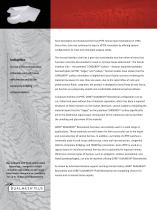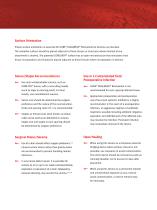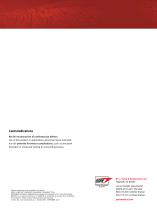 Website:
Gore
Website:
Gore
Catalog excerpts

Proven visceral protection Versatile material - easily trimmable to fit defect CORDUROY® surface for tissue ingrowth Available with PLUS antimicrobial technology
Open the catalog to page 1
Gore developed and introduced the first ePTFE hernia repair biomaterial in 1983. Since then, Gore has continued to lead in ePTFE innovation by offering several configurations to meet and anticipate surgical needs. Indications For use in the reconstruction of hernias and soft tissue The visceral interface side has a pore size consistently less than three microns that has been clinically documented to result in minimal tissue attachment1. The fascial interface side – the patented* CORDUROY® surface – features expanded polytetrafluoroethylene (ePTFE) “ridges” and “valleys.” Animal models have...
Open the catalog to page 2
Surface Orientation Proper surface orientation is essential for GORE® DUALMESH® Biomaterial to function as intended. The smoother surface should be placed adjacent to those tissues or structures where minimal tissue attachment is desired. The patented CORDUROY® surface has an open microstructure that stimulates host tissue incorporation and should be placed adjacent to those tissues where incorporation is desired. Suture/Staple Recommendations Use in a Contaminated Field Postoperative Infection Use only nonabsorbable sutures, such as GORE-TEX® Suture, with a noncutting needle GORE®...
Open the catalog to page 3
1. Koehler Rh, Begos D, et al. Minimal adhesions to ePTFE mesh after laparoscopic ventral incisional hernia repair: Reoperative findings in 65 cases. J Soc Lapar Surg 2003; 7(4): 335-340. 2. Nealon TF. Fundamental skills in surgery. Philadelphia: Saunders, 1979:47. 3. Nyhus LM, Condon RE, eds. Hernia. 4th ed. Philadelphia: Lippincott, 1995:331-6. 4. Hamer-Hodges DW, Scott NB. Replacement of an abdominal wall defect using expanded PTFE sheet (GORE-TEX). J R Coll Surg Edinb 1985;30:65-7. 5. Ponka JL. Hernias of the abdominal wall. Philadelphia: Saunders, 1980:339, 352, 392. 6. Durden JG,...
Open the catalog to page 4
At 16 months, GORE® DUALMESH® Biomaterial develops a neomesothelialization or reperitonealization on the visceral side. Abdominal Wall Surface Tension, N/cm error bars represent 99% P.I. Covidien PARIETEX® Composite Ethicon PROCEED® Surgical Mesh Based upon the samples tested, GORE® DUALMESH® Biomaterial has a statistically higher abdominal wall surface tension than either PARIETEX® composite or PROCEED® mesh*, which is above the clinically calculated strength requirement of 32 N/cm9,10,11. The absorbable barriers were removed prior to testing simply by soaking in water in order to assess...
Open the catalog to page 5
Contraindications Not for reconstruction of cardiovascular defects. Use of this product in applications other than those indicated has the potential for serious complications, such as aneurysm formation or undesired healing to surrounding tissues. W. L. Gore & Associates, Inc. Flagstaff, AZ 86004 Products listed may not be available in all markets. GORE®, GORE-TEX®, CORDUROY®, DUALMESH®, DUALMESH® PLUS, PERFORMANCE THROUGH EXPERIENCE, and designs are trademarks of W. L. Gore & Associates. PROCEED, is a trademark of Ethicon, Inc. PARIETEX is a trademark of Covidien AG or its affiliates. *US...
Open the catalog to page 6All Gore catalogs and technical brochures
-
Decades of data
2 Pages
-
CONFIGURATIONS
2 Pages
-
Care and Cannulation
9 Pages
-
Introducing
4 Pages
-
ADULT IC CARDIOFORM BROCHURE
8 Pages
-
Brochure Product
4 Pages
-
Pediatric Patient Booklet
36 Pages
-
GORE TIPS Needle
4 Pages
-
GORE® VIABIL®
4 Pages
-
Endovascular
28 Pages
-
GORE-TEX®
4 Pages
-
GORE® SYNECOR Biomaterial
1 Pages
-
GORE® SYNECOR
8 Pages
-
GORE-TEX® Suture
6 Pages
-
Cardiothoracic Portfolio
8 Pages
-
Hemodynamic Flow Brochure
4 Pages
-
Product Brochure
4 Pages
-
GORE 3D Imaging System
8 Pages
-
GORE® VIABAHN®
8 Pages
-
GORE® VIABAHN®
24 Pages
-
GORE® SEAMGUARD®
5 Pages
































